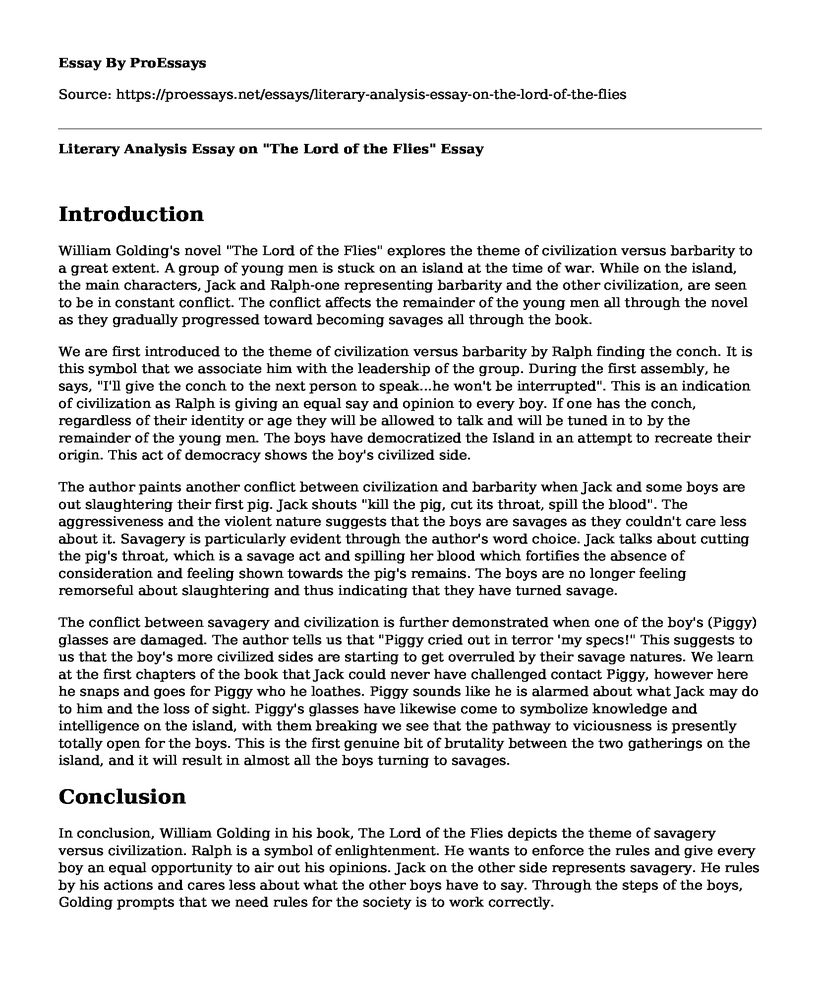Introduction
William Golding's novel "The Lord of the Flies" explores the theme of civilization versus barbarity to a great extent. A group of young men is stuck on an island at the time of war. While on the island, the main characters, Jack and Ralph-one representing barbarity and the other civilization, are seen to be in constant conflict. The conflict affects the remainder of the young men all through the novel as they gradually progressed toward becoming savages all through the book.
We are first introduced to the theme of civilization versus barbarity by Ralph finding the conch. It is this symbol that we associate him with the leadership of the group. During the first assembly, he says, "I'll give the conch to the next person to speak...he won't be interrupted". This is an indication of civilization as Ralph is giving an equal say and opinion to every boy. If one has the conch, regardless of their identity or age they will be allowed to talk and will be tuned in to by the remainder of the young men. The boys have democratized the Island in an attempt to recreate their origin. This act of democracy shows the boy's civilized side.
The author paints another conflict between civilization and barbarity when Jack and some boys are out slaughtering their first pig. Jack shouts "kill the pig, cut its throat, spill the blood". The aggressiveness and the violent nature suggests that the boys are savages as they couldn't care less about it. Savagery is particularly evident through the author's word choice. Jack talks about cutting the pig's throat, which is a savage act and spilling her blood which fortifies the absence of consideration and feeling shown towards the pig's remains. The boys are no longer feeling remorseful about slaughtering and thus indicating that they have turned savage.
The conflict between savagery and civilization is further demonstrated when one of the boy's (Piggy) glasses are damaged. The author tells us that "Piggy cried out in terror 'my specs!" This suggests to us that the boy's more civilized sides are starting to get overruled by their savage natures. We learn at the first chapters of the book that Jack could never have challenged contact Piggy, however here he snaps and goes for Piggy who he loathes. Piggy sounds like he is alarmed about what Jack may do to him and the loss of sight. Piggy's glasses have likewise come to symbolize knowledge and intelligence on the island, with them breaking we see that the pathway to viciousness is presently totally open for the boys. This is the first genuine bit of brutality between the two gatherings on the island, and it will result in almost all the boys turning to savages.
Conclusion
In conclusion, William Golding in his book, The Lord of the Flies depicts the theme of savagery versus civilization. Ralph is a symbol of enlightenment. He wants to enforce the rules and give every boy an equal opportunity to air out his opinions. Jack on the other side represents savagery. He rules by his actions and cares less about what the other boys have to say. Through the steps of the boys, Golding prompts that we need rules for the society is to work correctly.
Cite this page
Literary Analysis Essay on "The Lord of the Flies". (2022, Dec 11). Retrieved from https://proessays.net/essays/literary-analysis-essay-on-the-lord-of-the-flies
If you are the original author of this essay and no longer wish to have it published on the ProEssays website, please click below to request its removal:
- Critique of Dissent From War by Robert Ivie Essay
- The Theme of Moral Corruption in The Great Gatsby Novel: Critical Essay
- The Myth of Romulus and Remus Essay
- Questions on the Mahabharata's the Epic Story Paper Example
- Comparing Seasons of the Mist and Paradise Lost Essay Example
- Essay Example on Aesir-Vanir War: Ancient Conflict of Norse Deities
- Essay on Insights and Epiphanies: Understanding the Narrator's Transformation in 'Cathedral'







